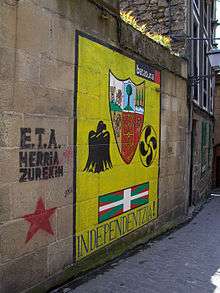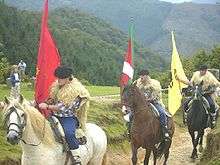Arrano beltza


The arrano beltza ("black eagle" in Basque) is an ancient Basque and Navarre symbol which shows a black eagle upon a yellow background. Today it is mostly, though not exclusively, used by Basque nationalists as a symbol of Euskal Herria.
History
The black eagle was originally the seal of King Sancho VII of Navarre but was later attributed to Sancho III of Navarre who, when incorporating Aragon and Castile, had under his crown all the territories of Basque culture and language, including those traditionally Castilian, since his kingdom reached from Galicia to Ribagorza. From a Basque nationalist interpretation, the rule of Sancho III constitutes a historical precedent for the aspirations of the unification of the Basque-speaking territories under one independent State. From a Spanish perspective, it is one of the first attempts at forming a unified Spain.
Note that the flag is a modern interpretation of the seal. There are no known flags prior to the 18th century[1] when Father Isla describes a crimson flag with the chains and crown of the modern coat-of-arms.
Use by Basque nationalists
This symbol is used mostly by the so-called Ezker Abertzalea (Nationalist Left), who consider it "the oldest symbol of the territory of Euskal Herria". Such use fits in with the search for symbols and terms which go beyond the iconography created by Sabino Arana. Thus, besides the ikurriña (the official flag in the Basque Autonomous Community), of Aranist origin, one can find the yellow flag with the black eagle and the flag of Navarre being used more often, as they are considered more genuine symbols of Euskal Herria. For the same reason, these leftist abertzaleak often use the traditional term Euskal Herria instead of the neologism Euskadi, created by Sabino Arana in the 19th century. (Euskadi, on the other hand, is starting to be more usually identified with the Basque Autonomous Community.)
Occasional use by Spanish nationalists
Some Spanish nationalist organisations of neo-fascist character (specifically the AUN), have on a few occasions used the arrano beltza as well, presenting it as a symbol of Spanish unity. For this idea, they allege that Sancho III ruled most of Christian Spain, from León to Barcelona, and that he appeared in many documents named as Rex Hispanorum Regum, that is, "King of the Kings of the Hispanians" (Spaniards), which, from their point of view, demonstrates that the Kingdom of Navarre perceived Spain as a territorial and historical unit, despite its political division (although it is debatable whether Hispania was then a merely geographical term, like its modern-day substitute Iberia).
See also
Arrano beltza is also a song by Basque songwriter Mikel Laboa (later covered by rock band Negu Gorriak), including the verses:
| Arrano beltzarekin joan ziren joan joan Jaengo Navas de Tolosara Nafarrak eta kate kateekin itzuli etxera. |
They went with the black eagle went, went to Navas de Tolosa in Jaén the Navarrese and returned with the chains, chains. |
It alludes to a legend about the origin of the coat of arms and flag of Navarre.
References
- Much of the content of this article comes from the equivalent Spanish-language Wikipedia article.
- ↑ Bernardo Estornés Lasa's Spanish article on Navarra in the Auñamendi Entziklopedia (click on "NAVARRA - NAFARROA (NOMBRE Y EMBLEMAS)")